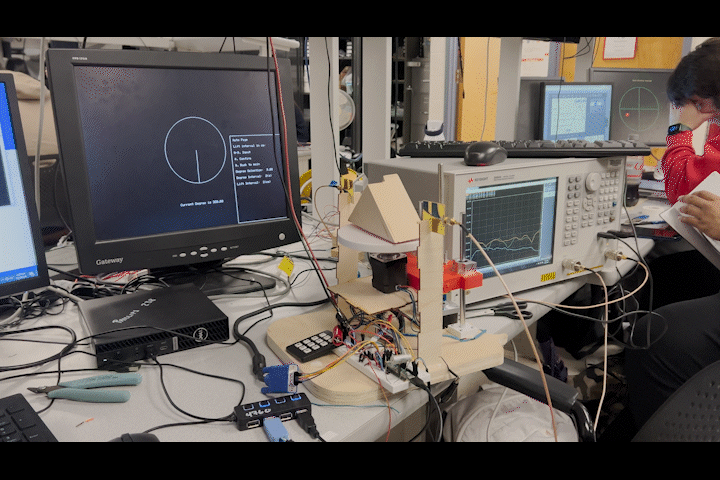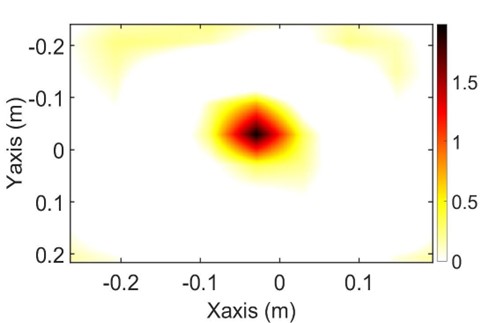High Level Design
Microwave Imaging, an emerging modality, holds the potential to complement established methods like Magnetic Resonance Imaging (MRI) and Computed Tomography (CT). Its affordability, non-invasiveness, and portability make Microwave Imaging well-suited for early tumor detection. In this study, we used a microwave imaging system using a prototype scanner with two Vivaldi antennas transmitting and receiving signals from 2.5 GHz- 8 GHz. A pyramidal shaped homogeneous wood phantom served as the scanned object. The acquired data from the Vector Network Analyzer (VNA), represented by the S21 parameter on the receiving antenna, was collected for input into the reconstruction algorithm. Filtered Back Projection (FBP) is used as the reconstruction algorithm having a Hann window as the filter for optimal results. Qualitatively, the FBP reconstructed image exhibited smoother quality with clearer edges with decent processing time. In the future, multiple 2D scans at different heights of the object can generate the 3D cross-sectional image by implementing the MATLAB code.
Microwave Imaging detects tumors by discerning variations in permittivity profiles or distributions between normal and abnormal cells. Two prevalent methods for reconstructing images in microwave imaging are the reflection method and transmission method [1]. The reflection method involves utilizing scattered fields captured by multiple receiver antennas. In this approach, the reconstructed image is derived by solving the electromagnetic inverse scattering problem, specifically the object's permittivity profile [2]. Drawbacks include the need for numerous receiver antennas and the computational complexity coming from the non-linear nature of the inverse scattering problem. On the other hand, the transmission method relies on the attenuation profile of electromagnetic waves penetrating the object [1]. This method assumes straight-line or ray-based electromagnetic propagation, resulting in simpler mathematics and a reduced need for receiver antennas compared to the reflection method.
In prior research, a microwave imaging system was simulated in Computer Simulation Technology (CST) software using a straightforward cylindrical phantom as the scanned object [3, 4, 5]. The phantom's image was successfully reconstructed using the transmission method. The formation of a reconstructed image through the transmission method involves employing an algorithm alike to that used in CT scans, focusing on generating the material permittivity distribution of the object. The analytic approach relies on mathematical formulations, offering speed and elegance but lacking the capability to address complex issues such as scattering phenomena. The simplest algorithm within the analytic method is Filtered Back Projection (FBP), where the Fourier Slice Theorem is applied for image formation [6]. The acquired measurement data can be modeled using the Forward Problem, expressed by Eq. (1), commonly known as the Radon Transform. Here, PΘ(t) represents the attenuation profile (assumed to be the S21 parameter in microwave imaging), known as the sinogram, and fx,y represents the 2D image to be reconstructed. The image can be reconstructed from the acquired measurement data by applying the Inverse Problem, as formulated in Eq. (2).

To generate an accurate representation of scatterers within a specific imaging area, the intensity distribution of scattered waves in that area is determined by analyzing the fields received at various antenna locations surrounding the area. A Vivaldi antenna at one end emits electromagnetic waves and another collects the waves that are scattered from the object and this process is continuous for Np antenna positions encircling the imaging area. For each frequency increment (m = 1 to Nf) and from every point (x, y) within the imaging zone, the scattered electromagnetic field (Escat) is calculated. This calculation is based on the S-parameters (Smeas), which are signals measured at each antenna position (n = 1 to Np) around the imaging area. The process of measuring across all antenna locations and frequency increments yields a total of Nf x Np values representing the estimated scattered field at every point within the imaged area used for image reconstruction.
hardware/software tradeoffs: This imaging method and MATLAB code cannot disguise the edges of the object perfectly. Currently, 3D image reconstruction is also not possible as it needs a decent amount of time to write the MATLAB code, but it can be done in future.
Experimental setup:
The proposed microwave imaging system comprises two primary components: measurement-oriented hardware and reconstruction-focused software in MATLAB to generate images of scanned objects from acquired measurement data. The hardware component includes two Vivaldi antennas for transmitting (Tx) and receiving (Rx) microwave signals from 2.5 GHz-8 GHz; a Vector Network Analyzer for signal generation and S21 parameter measurement; and a proposed scanner system having various hardware components. The scanner is equipped with step motors and microcontrollers for data acquisition as shown in Fig.1.To assess the performance of the Filtered Back Projection (FBP) algorithms, a pyramidal shaped wood phantom with a relative permittivity Εr of 2-3 is employed as the material under test (MUT). During measurement, both Vivaldi antennas (Tx-Rx) are positioned 23 cm apart, translating together along the object. The S21 parameter is then acquired from the Vector Network Analyzer at each position. Following the translation process, the antennas are rotated at specific degrees (such as 9 or 18 degrees), and the translation process is repeated until the end of the rotation degree (complete 360-degree scan).









